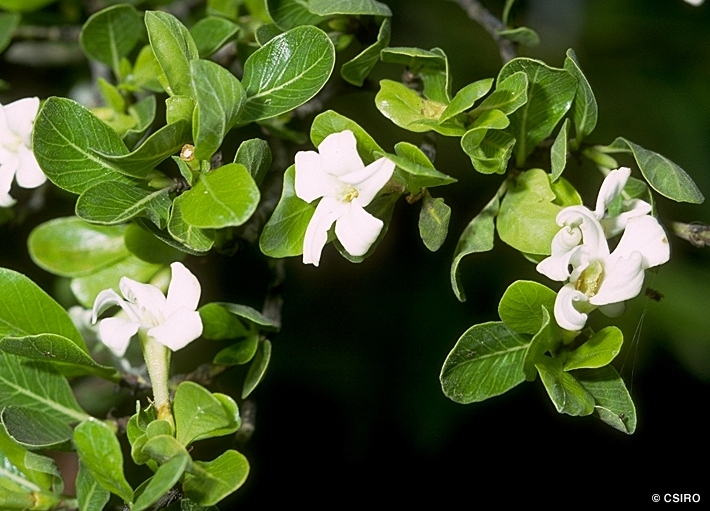Australian Tropical Rainforest Plants - Online edition
Gardenia vilhelmii Domin





Domin, K. (1928) Bibliotheca Botanica 89(4): 1174. Type: Nord-Queensland: savannenwalder zwischen Chillagoe und dem Walsh River (DOMIN II. 1910). Holo: PR.
Can grow into a small tree but usually flowers and fruits as a shrub. Deciduous for a short period during the dry season.
Stipules about 3-5 mm long, encircling the twigs. Stipules, young shoots and terminal buds sticky or resinous. Leaves crowded at the ends of the much branched twigs, leaf blades about 1-3.5 x 0.6-2 cm, petioles about 1-3 cm long. Lateral veins forming loops inside the blade margins. Domatia are inconspicuous tufts of hair covering pits.
Flowers solitary, pleasantly perfumed, the odour perhaps resembling peaches (Prunus persica). Calyx and corolla (at least in bud) clothed in yellow wax or resin. Calyx tube (hypanthium) cylindrical, about 1-3 mm long, lobes or free parts about 1 mm long. Corolla tube expanded towards the apex, tube about 6-17 mm long, lobes about 5-10 mm long, the whole flower about 20 mm diam. Anthers about 4-8 mm long, slightly exceeding the corolla tube. Male flower with a well developed ovary (containing numerous small ovule-like ovulodes) terminating in a large white or cream style and stigma which only just exceeds the corolla tube. Female flowers with three stigmas, located along the upper style which protrudes about 5-7 mm beyond the corolla tube.
Fruits globular, about 9-16 mm diam. Seeds +/- patelliform, about 2-3.2 mm diam. Cotyledons about twice as wide as the radicle.
Endemic to NEQ. Altitudinal range from near sea level to 600 m. Usually grows in open eucalypt forest but also occurs in monsoon forest and vine thickets.
This plant used medicinally by Aborigines, used for toothache. Cribb (1981).





